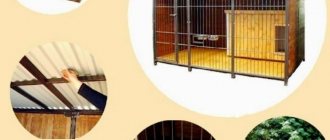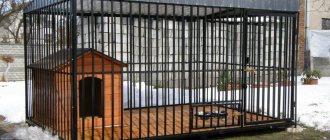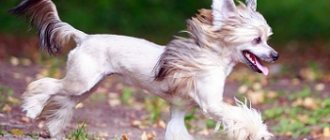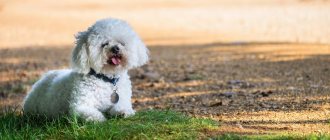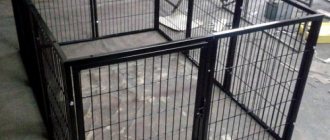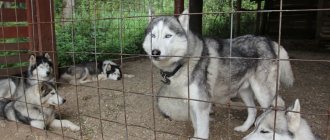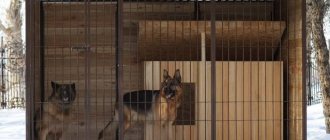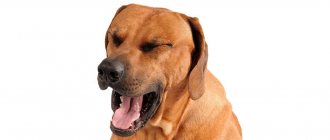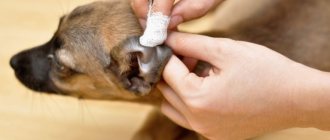Enclosure sizes requirements and calculations
To build an enclosure for a dog with your own hands, prepare a drawing with dimensions. This will make it easier for you to decide on the right amount of building materials. Sizes are selected according to generally accepted standards developed by experienced dog breeders. You also need to focus on the breed of your pet; some of them require an individual approach.
Size depends on breed
General standards and requirements
The size of the enclosures depends on the size of the dog, its breed, and the number of animals simultaneously living in the same area. Of course, an enclosure for a small dog can be much smaller in area compared to one for a large breed. Approximate standards that it is advisable to comply with:
- dogs taller than 65 cm at the withers - the area of the enclosure is at least 10 m2;
- from 50 to 65 cm at the withers – area from 8 m2;
- height less than 50 cm - from 6 m2.
A universal scheme with dimensions for an animal of any size
An enclosure for several dogs or for a mother with puppies should be more spacious. For two adult individuals, a fence with an area of one and a half times larger than the norm for one is suitable. You can build a separate booth for each of the animals, or you can limit yourself to one fairly spacious room with enough space for everyone.
An enclosure for an average dog should have three zones:
- winter road (booth or other room);
- open part of the paddock;
- part of the paddock under a canopy.
Approximate space zoning scheme
One half of the walk should be located on the platform, the other - on the open ground. With this distribution of territory, the four-legged friend will be able to walk in any weather, if desired, bask in the sun or hide from the heat or rain under the roof.
Calculation of area depending on breed
Sizes should be selected taking into account the characteristics of the breed. Huge dog enclosures will be a joy for active large animals, while tiny breeds will begin to feel uncomfortable there.
An outdoor enclosure for dwarf dogs cannot be their habitat all year round. These breeds do not winter outside in our climate. Such a cage can serve as a temporary fence for walking a pet in the yard, or it can be installed in an apartment.
In such a house, Alabai will be the rightful owner
Large breeds require a special approach to organizing their home. In a low or too small enclosure, the animal will be uncomfortable and this may affect its health and character. The dimensions for the Alabai must correspond to the standards for large dogs. Take care of the height of the fence. The dog can jump over a fence up to 3 meters high.
The enclosure for husky dogs deserves a separate discussion. This breed is distinguished by its activity. It is not advisable to keep a husky in the house - she needs space and a place to walk. Huskies have an average height of up to 60 cm at the withers. But for them it is better to arrange a fenced area with a larger area - about 10-15 square meters. A rectangle with an aspect ratio of 2:3 is considered the optimal fencing option for huskies.
Huskies need to be constantly on the move - this is a feature of the breed.
The popular raccoon breed also prefers to live in a specially designated area in the yard. The enclosure for a raccoon dog must be at least 6 square meters, fenced both at the top and bottom. There is a high probability that the animal will want to leave the cage and will begin to dig in the ground near the wall. You must be sure that your pet will not chew through the fencing material or break it.
General characteristics of muzzles
The mesh of the metal muzzle is made of nickel-plated wire. Some meshes may have a leather lining to protect the Rottweiler's short coat from abrasion. These muzzles are durable and do not require special care. The mesh does not make breathing difficult, but eliminates the possibility of bites.
However, the mesh cannot be used in winter - the Rottweiler's lips and tongue may stick to the metal. And in wet weather, the metal can become rusty. Due to leather inserts, diaper rash often appears on the dog's skin. During training, you run the risk of injury from being hit by a metal muzzle.
Closed leather muzzles can completely protect passers-by from Rottweiler bites. They are tightly fixed on the dog's face, leaving only the nose free. To prevent the Rottweiler's skin from suffering, the muzzle has holes for air ventilation. This muzzle is convenient in cold and rainy seasons. But in hot weather it is better to avoid it - the animal will not be able to breathe in it, sticking out its tongue.
Leather “baskets” are used in any weather. In it, the Rottweiler will breathe and drink some water with his tongue hanging out. He will also be able to pick up garbage from the ground. So the “basket” is only put on trained dogs who obey their owner unquestioningly. A few more disadvantages: leather “baskets” need to be constantly cleaned and lubricated with special oil. Over time, they become unusable.
Plastic muzzles are an excellent replacement for “baskets”. They are also used in any weather. At the same time, muzzles prevent dog bites and are easy to care for. But even here there are some drawbacks. Plastic can rub your dog's skin or crack at the wrong time.
For walks in public places, a bridle muzzle is suitable. It will securely fix the Rottweiler's mouth right in the middle, preventing its powerful jaws from opening. Wear-resistant and low-maintenance bridles are suitable for any time of year.
DIY dog enclosure materials
How to make a CCTV camera from a phone
If you are building a permanent rather than temporary enclosure, then it is important to protect the dog from wind and bad weather. First of all, you need to build a good back wall of the enclosure. The following materials are suitable for it:
- Monolithic concrete;
- Brick;
- Cinder block;
- Wooden shield.
Open walls are best made from metal rods rather than mesh. Even though the rods are more expensive, they will last much longer. The net can be installed for a small dog, but this option is not suitable for a large one.
For the floor, the ideal solution would be boards coated with a special wood primer. Concrete floor is not the best solution. Firstly, it is cold, and secondly, the dog can damage its paw on it. If you make a concrete floor, be sure to lay a wooden floor on top. You need to spend enough time installing a wooden floor to avoid cracks, protruding knots and other things.
Important! Do not place boards directly on the ground. The tree will quickly rot and you will have to do everything again
The best option is to make a stand and waterproof the soil using roofing material.
Regarding the roof, it can be made from any material that does not allow water to pass through. Corrugated sheets, slate, tiles can cope with this. The main thing is that the roof is sloped to avoid stagnation of water.
Construction process
First of all, you need a drawing. Don’t be upset if you don’t have architectural skills, just place it on a piece of paper where the booth, feeder and the platform itself will be located. Remember that the enclosure should have three conditionally separated zones - a resting area, feeding and walking, where the dog can simply play. But even knowing this, it is quite difficult to understand how to make an enclosure for a dog with your own hands.
Therefore, we provide a description of the step-by-step process. If you have already chosen a location, purchased materials and drawn a drawing, you can begin construction:
- First, you need to pour the foundation. This is necessary to ensure that the walls do not deform and the soil does not sag.
- When the foundation is in place, you can begin welding the frame if the enclosure is metal or building walls if it is brick.
- If the enclosure is made of wood, then it is advisable to make the frame metal, but the lining is made of wood.
- Whatever you choose, one of the sides of the future structure should be made of rods so that the dog has a clear view. Don't forget about the gate! Whatever it is, there is an important nuance - it should always open inward.
- When the frame is ready and installed, you can start working on the floor.
As we said above, concrete is the worst option, although it is the most common. In winter, the dog will be cold, as a result of which it can easily get sick. The best choice is wooden floors, but they will need to be constantly treated with an antiseptic. Another option is to simply fill the floor of the enclosure with crushed stone and sand. True, until such masonry is compacted, it will not be very convenient. Especially cleaning up after the dog. The roof can be made from ordinary corrugated sheets, slate and even fabric material. It is enough to weld the frame and stretch the fabric. The option is, of course, the most affordable, but it is not known whether such a roof will withstand strong winds and heavy snow. Therefore, it is better to overpay a little, but build a roof from something more substantial.
Is it possible not to build?
In fact, you can buy a dog enclosure and thereby avoid all the subtleties. This will of course be more expensive, but if you don’t have time or don’t want to bother, you can go the easy way. All you have to do is assemble and install it. And if you still decide to build an enclosure for a dog with your own hands, then look at the photo below.
Detailed construction stage in this video.
Where should you build an enclosure for a dog?
To build an enclosure for a dog with your own hands, you need to choose the right place. The building should be located in close proximity to a private house. If the pet is located far from the owner, it will begin to show excessive nervousness. This contributes to loud barking and restlessness in the animal’s behavior.
Expert opinion
Anna Abramenko
An avid dog lover. Experience in veterinary medicine since 2009.
Ask a Question
Placing the enclosure along the perimeter of the fence may encourage the dog to become overly interested in sounds from people passing by. Also, a large pet can easily jump over the fence and cause possible difficulties.
Note! It is prohibited to erect such buildings near compost or other sources of pungent odors. This can cause the animal to completely or partially lose its sense of smell.
Wall installation
DIY block staircase
It's time to talk about what to make the enclosure out of. The wall serves as an obstacle for the pet so that it cannot leave the territory without your desire, and also protects it from wind, bad weather and the scorching sun, and the dog also needs at least one lattice wall for contact with the environment and observation.
Nails should not be used to install walls, as an animal can tear them out; it is better to use self-tapping screws. In order to save money, you should not replace the grate with a mesh; not only can the dog break it, he can also get injured by it, as he will bite it.
For a large adult individual, a distance of 10 centimeters between the rods is suitable, for small ones - less. The main thing is that the dog's head cannot get stuck in the bars.
Choosing a suitable location for the enclosure
With your own hands - How to do it yourself How to make the right foundation for a house
Before you build a dog enclosure, you need to find a suitable place to place it. As with construction, a certain number of rules must also be observed here, namely:
- The enclosure should be located as far as possible from various noise sources. Passers-by on the street, loud neighbors, cars, all of this, to one degree or another, can cause concern for your beloved pet. A short distance from the porch of the house (7-10 meters) will be an ideal location for a dog enclosure.
- Lowland is also an extremely undesirable place to build an enclosure. After heavy rains, all the water from the site will accumulate there, turning the area into a real swamp. A solution to the problem may be drainage ditches or installation of storm drainage on the site, but this will lead to additional financial costs.
- A dog, like a person, does not tolerate foul odors very well, the source of which can be: sewerage, a compost pit, fertilizer from the garden, a trash can located next to the enclosure, etc. Try to plan the structure so that it is located as far as possible from the data foul-smelling sources.
- To prevent your dog from getting too hot in the summer, you should position the enclosure so that its front part faces the east or west. If this is not possible, plant a small tree near the building that will protect your four-legged companion from bright sunlight.
Stationary dog enclosure made in beautiful colors
A small insulated enclosure that is perfect for a medium-sized dog
If necessary, the stationary enclosure can be moved to any suitable place
In order not to lose sight of any little detail, at the initial design stage it is advisable to draw a detailed plan (drawing) of the future enclosure. It must contain information about the size of the structure, the materials from which it will be made, its location, the location of internal zones, etc.
DIY enclosure construction - drawing
We build an aviary ourselves
Do-it-yourself dog enclosure is a job that does not require engineering training.
Therefore, we will not tell you how to drive pillars into the ground and hang a gate - almost every man knows and can do this.
But practical advice on arranging the floor, walls, and booths will be useful - this way you can provide for all the details.
Floors in the enclosure
Usually enclosures are simply built on the ground. But if we are talking about a civilized place for a dog, then such a floor is not practical.
In winter, the ground freezes and the animal's paws may become cold.
In spring and autumn, during the rainy season, the enclosure will be so muddy that you will hardly want to let it run around the yard.
Therefore, it is better to make the floor concrete, brick, tile, asphalt or wood.
The exception is cement flooring. In any weather it is cold (the cold is contained inside), which means there is a risk of rheumatism in dogs.
Stone or wood floors are easier to keep clean.
When building an enclosure, you can use this scheme
Feature of wooden floor
Wood is susceptible to rotting, so it is worth making a gap of 5 cm under the flooring for ventilation (this is the principle used to lay floors on the terrace) and as protection against the penetration of various insects from the ground.
Monitor the quality of the boards - they must be perfectly planed, dried, without knots, so that splinters do not even accidentally fall into the pet’s paws.
Aviary walls
We have already mentioned above the chain-link mesh for walls.
It is worth considering that if a dog is active and has a strong character, it may try to bite through the mesh, thereby damaging its teeth or knocking it out in a jump.
Therefore, if you decide to make an aviary with your own hands, think about a different material for the walls.
A lattice fence made of pipes, albeit small in diameter, will do.
The pipes are cemented every 5 cm if the dog is not very large, such as a Cairn Terrier, Wolfspitz, or Miniature Schnauzer, or every 10 cm if your guard is a large breed of dog, such as a Leonberger, Cane Corso, Hovawart or Groenendael.
This concerns one of the walls that opens a view of what is happening in the courtyard.
Other walls can be made blank, at least one or two.
To do this, use wooden panels, corrugated sheets, flat slate.
You can attach the enclosure to the brick wall of the garage, but there is a risk that the dog will perceive the wall as a tree during a walk.
It is worth considering that a dog, if it is active and has a strong character, may try to bite through the mesh, thereby ruining its teeth or knocking it out in a jump
The requirements for a wooden wall are the same as for the floor - the board must be dry, smoothly planed, free of knots, and treated with agents that prevent rotting.
The boards are fastened like a laminate (grooves + ridges), and additionally reinforced with screws.
Don't forget to drill holes for them in advance, otherwise the board may split.
Entrance to the enclosure
Making an enclosure for a dog and not providing an entrance to it is nonsense.
The entrance, that is, the gate, should not be blind - you should see the dog when you approach.
This means that it needs to be installed from the side of the lattice wall - usually this is the front side.
The door should open inward so that the animal cannot jump out.
A lock is needed not only on the outside of the enclosure. Provide a latch or bolt inside.
Luxurious enclosure with a swimming pool
Aviary roof
There are no special requirements for the roof. It is covered with bituminous materials, corrugated sheets, slate, and metal tiles.
The main thing is that the walls of the enclosure can withstand the roof + precipitation pressure: rain, snow, leaves.
The roof should be installed at an angle to allow water to drain rather than be retained.
Aviary interior
How to build an enclosure for a dog is already clear. All that remains is to equip it from the inside: make a booth, install a feeder and a drinking bowl.
It is better to place the feeder and drinker not on the floor, but on a 20-centimeter stand.
This way, the bowl will not slide on the floor, and the dog will not have to constantly bend over.
The kennel is your pet's refuge, so it should be spacious enough for your dog to rest in it.
Dog enclosures can look very attractive, performing not only the function of housing for a pet, but also decorating your garden
There should be no drafts in the kennel. If you live in northern or windy areas, you will need to insulate the walls of the booth, making them double and with insulation inside.
For the same reason, a canvas curtain is hung on the door. The roof of the booth should be flat, slightly sloping and removable.
Firstly, dogs love to lie on the roof, and secondly, the removable roof makes it easier to clean the kennel and take care of the dog if it gets sick.
The area of the enclosure allows - give the dog a summer floor, as it can be hot in the kennel.
The dog should feel comfortable in its enclosure. But don't forget to let her out for a walk sometimes
We are building a booth
We start building the booth from the bottom. The bottom of the booth should be made of two layers. Next, a frame of timber with a section of 50 by 50 mm is assembled above the bottom. Then we line the inner wall of the kennel with wooden clapboard. We lay the walls and ceiling between the skins with mineral wool or expanded polystyrene, lined with film. We cover the outer part with the same wooden clapboard.
The roof can be made gable or single-pitch. We recommend making it single-slope so that the pet has the opportunity to do what he loves on the roof - watch his protected possessions. Choose a rough roofing material with an inclination angle of no more than 20 degrees. It is advisable that the roof can be opened for easy ventilation and cleaning of the dog’s home.
It is possible to wash a dog without water
We discussed simple options, but what to do if bathing is contraindicated for a dog, how to wash a dog without water? There may be several reasons to think about it: bathing is contraindicated for old dogs due to the high likelihood of catching a cold, skin eczema progresses upon contact with water, healing wounds or sutures should be protected from moisture. The simplest option is that the dog is dirty, how to wash it if it is afraid of water?
There is an exit! At first, resourceful women tried this method on themselves, and then the idea was picked up by canine cosmetologists. To clean wool, powder is used, the main part is talc, auxiliary elements disinfect and disinfect the skin. The product is available in jars similar to baby powder. The powder is distributed over a small area, after which the wool is carefully combed
It is important to thoroughly comb the dog before bathing, to remove excess undercoat and tangles. This type of reading does not require additional procedures.
General considerations about the aviary
It is worth noting that, for all its simplicity, building an enclosure is not the most primitive thing. The main thing in it is the design and choice of material, as well as taking into account the characteristics of the dog. If these requirements are not met, the enclosure will become a source of inconvenience and problems for both you and your pet.
- The size of the enclosure depends on the size of the dog. If her height is:
- up to 0.5 meters at the withers, then she needs an area of 6 square meters. m;
from 0.5 meters to 0.65 meters – 8 sq. m;
- more than 0.65 meters – 10 sq. m.
- Floor. Most often it is made of concrete; it is easier to make it yourself. However, it should be taken into account that such a floor freezes very much and the dog can get cold paws. Therefore, it would be best to lay a wooden covering on top; in principle, a square of 2x2 m is enough.
- Walls. One of them, the front one, should look like a lattice, allowing the dog to observe the territory. It is best to weld it from pipes, for which it is advisable to use ordinary ones, galvanized pipes are harmful to health. The fence pitch for large dogs should be 100 mm, for small dogs – 50 mm. You should not use a mesh, as the animal will try to chew through it and ruin its teeth. Metal parts need to be processed - remove rust and also paint.
For the remaining walls, it is best to use wood, boards 20 mm thick: they must be well planed on all sides, and no loose knots or cracks are allowed on them. It is imperative that the boards be treated with antiseptic preparations and fastened with self-tapping screws.At the front of the enclosure there should be a door that opens inward and a feeder located at a distance of 200-300 mm from the floor surface. The door should have at least two locks (inside and outside) and eyelets for a padlock.
- Roof. Any material is suitable for it, but a soft coating is best. This will avoid excessively loud sounds during rain or hail, which are harmful to the dog's ears. When constructing a roof, the use of nails is unacceptable.
Similar sizes are necessary when keeping an animal around the clock. But if the dog has the opportunity to move freely around the territory, for example at night, then 6 square meters is enough to keep it. If several dogs live together, the area increases by about one and a half times. The same must be done when keeping a bitch with puppies.
Materials
It is believed that carefully sanded softwood boards without knots, stains and cracks are best suited for making a booth. But a popular material for this is pine board. Mineral wool, polystyrene foam, and felt are better suited as insulation.
To construct the roof, use a metal profile, slate or soft roofing. For exterior and interior decoration, use wooden lining.
What you will need for construction:
- timber 50 by 50mm;
- edged board 20 mm thick;
- nails 40 and 70 mm;
- galvanized self-tapping screws 40 and 60 mm;
- film;
- furniture stapler;
- screwdriver;
- hammer;
- moisture impregnation for wood;
- roofing material;
- insulation.
Types of dog enclosures
Depending on where the enclosure will be located, indoor and outdoor species are distinguished. The type that is suitable for the pet is selected based on the capabilities of the yard, climatic conditions, breed, gender and age of the animal.
With the right approach, an aviary can become a decoration of the yard
Outdoor housing for large dogs
The outdoor enclosure serves as a full-fledged home for the animal. The main functions that an outdoor enclosure for dogs should perform:
- protecting your pet from bad weather;
- restriction of territory for free walking;
- satisfying the animal's need for a home;
- ensuring the dog's safety.
Rough plan
To shelter your pet from rain or snow, be sure to make a canopy or roof, not relying only on a booth. If the precipitation is quite heavy and long-lasting, the animal will be able to stay in a shelter that is not limited to one square meter. Winter enclosures must be solid so that the dog does not freeze. Different heating systems are often used.
Not all owners are delighted with the idea that the dog will be able to roam freely around the property without restrictions. Large breeds can be a nuisance. The aviary solves this problem completely. The pet can stay inside around the clock with rare walks outside the territory, and sometimes the owners lock the dog only at night or when they expect strangers to come into the house.
Indoor outdoor aviary made of wood
One of the main requirements for dog housing is the availability of a walk. This is a spacious, uncluttered outdoor area to which the animal has free access. An enclosure with a walk allows the dog not to be cooped up all day. If you have a walk, it is convenient to train your pet.
Dogs are pets. They need a kennel and a territory that they are trusted to protect. A spacious enclosure for a large dog is not perceived as a cage; the pet is quite comfortable, but only if construction standards are observed.
When constructing enclosures for large dogs, wood or metal is usually used. These materials are strong enough to withstand the pressure of an adult animal; in addition, if the operating standards are observed, such a playpen will last a long time.
Shelter for two animals
Home shelters for dogs
An enclosure for a dog at home is simply necessary if:
- your pet has puppies;
- There is an indoor breed dog living in the apartment;
- other animals or small children appeared in the house.
A pregnant bitch needs a secluded place where she can be sure of the safety of her offspring. An indoor aviary could become such a place. In addition, slightly older puppies are very active and often, while playing, tear, break and gnaw everything that catches their eye. Before the puppies are given to new owners, it makes sense to keep them in a playpen.
Often in apartments you can find enclosures for small dogs. Living in such a “house”, the animal gets used to the fact that food, a place for the toilet, and a bed are always in one place. When the habit is developed, the dog will not leave marks in different corners of the room, but will get used to order.
If your beloved dog considers itself the master of the house, then with the appearance of another dog or, for example, a cat, the animal may begin to be jealous, nervous and protest. The same applies to families in which a child was born - sometimes the four-legged guest does not immediately react adequately. To protect the new residents of the house and help the animal adapt to new conditions, it is advisable to set up an enclosure for the dog at home.
A simple dog enclosure looks like a fence that can be installed anywhere in the room, and, if necessary, moved or assembled. This playpen will be comfortable for puppies who cannot get out or jump over the fence. While their mother will freely enter or exit the playpen.
Puppies will be safe, as will your property.
The cage cage limits the space for the animal not only on the sides, but also on the top. It is impossible for a dog to get out of such an enclosure on its own. They are used for short-term keeping of medium breeds or for permanent residence of small pets.
An aviary in an apartment is most often made of wood, metal or plastic. Designs and sizes vary, but there must be space for eating and drinking. Small dogs and puppies need a litter box inside the enclosure.
Interior arrangement of the enclosure
When building this structure, it is not enough to just build a safe and durable structure. Content is a determining factor in a dog’s quiet time. To do this, the following places must be equipped inside:
- Sun lounger. Can be made from straw, hay or an old mattress. Such a site must be built in a space protected from precipitation.
- Booth. When constructing this building, you should be guided by the rule: the dimensions of the house must exceed the dimensions of the animal by at least 1.5 times.
- Place for food. It is best to place bowls of food and water on separate racks or wall fixtures. As the animal grows, it is worth periodically adjusting the height of the containers.
The most important component of a dog’s comfortable stay in the yard of a private house is an enclosure. It’s easy to build it yourself, guided by the given rules and tips.
Construction of an aviary
The entire process of building an enclosure can be divided into 6 stages:
- sizing;
- selection of flooring material;
- wall installation;
- choice of roofing;
- door/gate installation;
- building a booth.
It would also be a good idea to provide a special “window” through which you can feed the dog without opening the enclosure door.
Sizing
The correct size of the enclosure is a very important parameter. If the enclosure is too small, it will be very difficult for your dog to stay in it. At the same time, pressure will be exerted not only on his psychological health - a cramped enclosure can become a breeding ground for diseases.
Of course, the larger the dog, the larger the enclosure should be. If a dog's height is 0.5 meters, it will feel great in a 6-meter-long enclosure; for pets whose height is 50-70 centimeters, it is necessary to build an 8-meter enclosure; for dogs of larger height, the length of the enclosure should start from 10 meters .
However, if you plan to periodically release your pet, the calculated size can be reduced by 1-2 meters.
Choosing flooring material
Of course, you can leave the floor earthen, but, as we have already said, firstly, it will be very difficult for your pet in the winter, and secondly, in the summer the dog will be constantly dirty. In addition, the pet can dig a hole and get out of the enclosure.
The easiest way is to make a concrete floor; it’s not a troublesome task - pour it in and wait until it dries. However, in winter, concrete gets very cold, and excessive cold can lead to rheumatism in your pet's paws.
Probably the best material for flooring is wood. However, there is an ideal option - concrete covered with wood on top. In this case, the dog will be comfortable and there is no need to be afraid that the flooring will quickly rot.
Wall installation
The material of the walls does not greatly affect the comfort of the pet, although, of course, he will be more comfortable in a wooden house than in a metal one. At the same time, the installation of wooden walls will be easier - when using metal, you will have to deal with welding, and this is not such a simple procedure. In addition, wood is cheaper, but wood still has one significant disadvantage - it is not as durable as metal.
If you choose durability over other advantages, you need to know that galvanized metal cannot be used, as it is harmful to animals.
The best option is to make three walls of metal or wood, and use mesh for one. Many people use chain-link mesh as a mesh, and this, of course, is economical, but dogs love to chew on the chain-link, thereby damaging their teeth, so it’s better not to skimp.
By the way, if you use wood, be sure to polish it and treat it with an antiseptic.
Door/gate installation
It is better to build the door into a lattice wall; you can even purchase a lattice in which the door is already built
Important! The door must open inward - this way the dog will not be able to get out on its own if you suddenly forget to lock the enclosure
How to build an enclosure for a dog sequence of actions
Having prepared the necessary material, taking into account the peculiarities of the location and zoning of the territory for the dog and using the instructions, building an enclosure will not take much time, will delight you with its beauty and your pet’s convenience
Choose a place
Away from compost pits, roads, borders with neighbors, so that nothing frightens or distracts the pet. It is better to place the enclosure close to the gate so that the area is easily visible from all sides. It is not recommended to place it away from home, behind outbuildings and other places where the dog cannot see the house and owners; in this case, it will be agitated and irritable, which will certainly develop into barking and whining.
Choosing a place for the enclosure. It is advisable that it be located in close proximity to the house
Draw a drawing of the future enclosure
It is important to consider the size of the dog: the larger the animal, the more space it needs. For medium-sized dogs (German shepherds, collies), the length of the enclosure is 7-8 meters
For small breed dogs the length is reduced by 2-3 meters, for larger breeds the length is increased.
The area of the enclosure must correspond to the height of the dog
The enclosure should have three main zones:
- Rest zone. This zone most often serves as a booth, where the dog can sleep and hide from the cold.
- Feeding area. A place where the dog can quench his thirst and hunger.
- Walking area. Here the dog will walk around, looking around the property.
